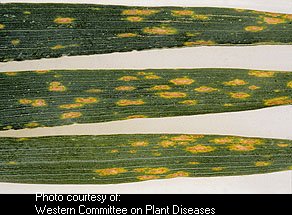Tan Spot In Wheat
Tan spot affects wheat, brome, and wheat grasses. Rye and barley are rarely affected and oats are resistant. Severe infection by tan spot in the seedling stage can kill or severely weaken plants. Re-seeding may be required.

Host Crops
Wheat, wheat grasses, and brome grass
Biology
Tan spot overwinters on standing wheat stubble, straw on the soil surface or partly buried by tillage, and on bales of wheat straw. Spores are produced in the spring and are carried by wind to growing plants. At least 6 hours of wetness are required for infection. Temperatures, ranging between 15-28 degrees C (60-82 degrees F), and periods of dew favour infection. Spores produced on diseased leaves tend to spread during the growing season under periods of wet weather.
Tan spot develops on both upper and lower leaves. The lesions first appear as tan-brown flecks that expand into lens-shaped lesions, similar to the lesions produced by the septoria leaf blotch fungus. Tan spot lesions range in size from 6-12 mm (1/4-1/2 in.) in length and are surrounded by a chlorotic (or yellow) border. As a lesion matures, the centre becomes darker because of the production of air-borne olive-brown spores that can infect other leaves, stems and plants. The infested straw that remains after harvest serves as the source of inoculum for the next season's wheat crop.
Symptoms Of Damage
Tan spot produces small tan-brown flecks on lower leaves which expand into lens- shaped brown blotches up to 12 mm (1/2 in.) long. These blotches often develop a small, dark-brown centre. Spots have yellow halos on leaves in June and early July. Large spots often coalesce when conditions are favourable for disease development. Heavily infected leaves may wither and die.
Scouting Techniques
Look for tan or brown flecks or yellow-rimmed blotches on the lower leaves. Later in the season, look for withered and dead leaves. Examine the heads for infected seed. Seeds infected with tan spot will usually appear smaller and shrivelled and may have a pinkish colouration.
Economic Thresholds
None available.
Control Tips
- Current varieties have little resistance.
- Crop rotation with barley and oats or non-host crops (e.g., canola, flax, corn, potatoes and alfalfa) will reduce disease carryover.
- Use wide row spacing to reduce in-crop humidity. Use adequate but not excessive fertilization to limit the disease.
- Turn under wheat residue to reduce the amount of surface straw that can produce air-borne spores during the growing season.
- Yield increases up to 15% have been reported when a fungicide was applied.
For further information, contact your GO representative.
